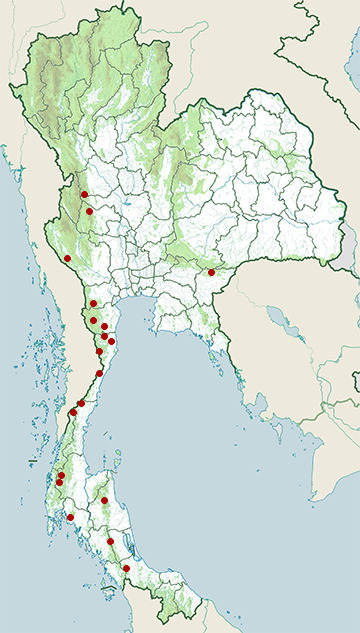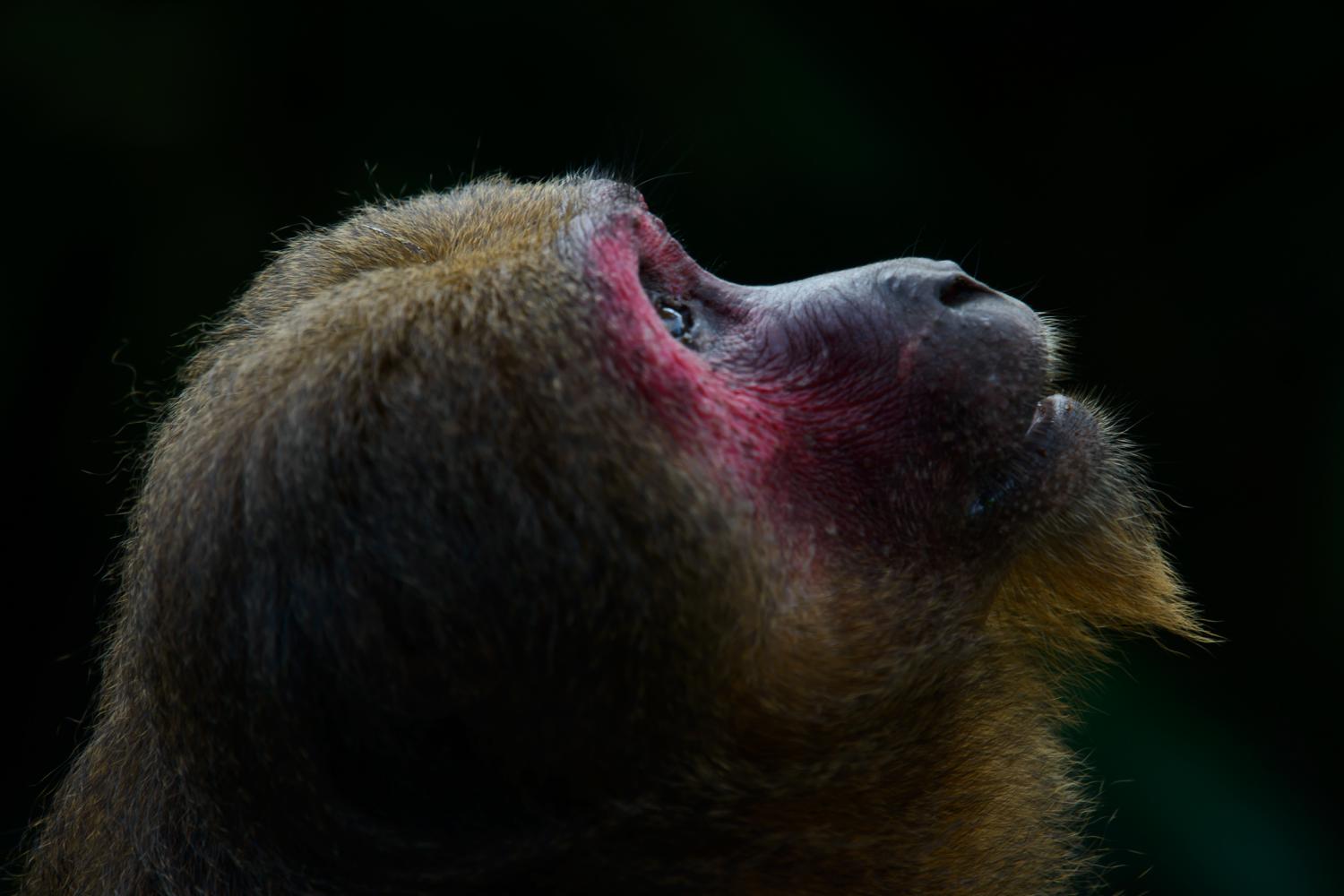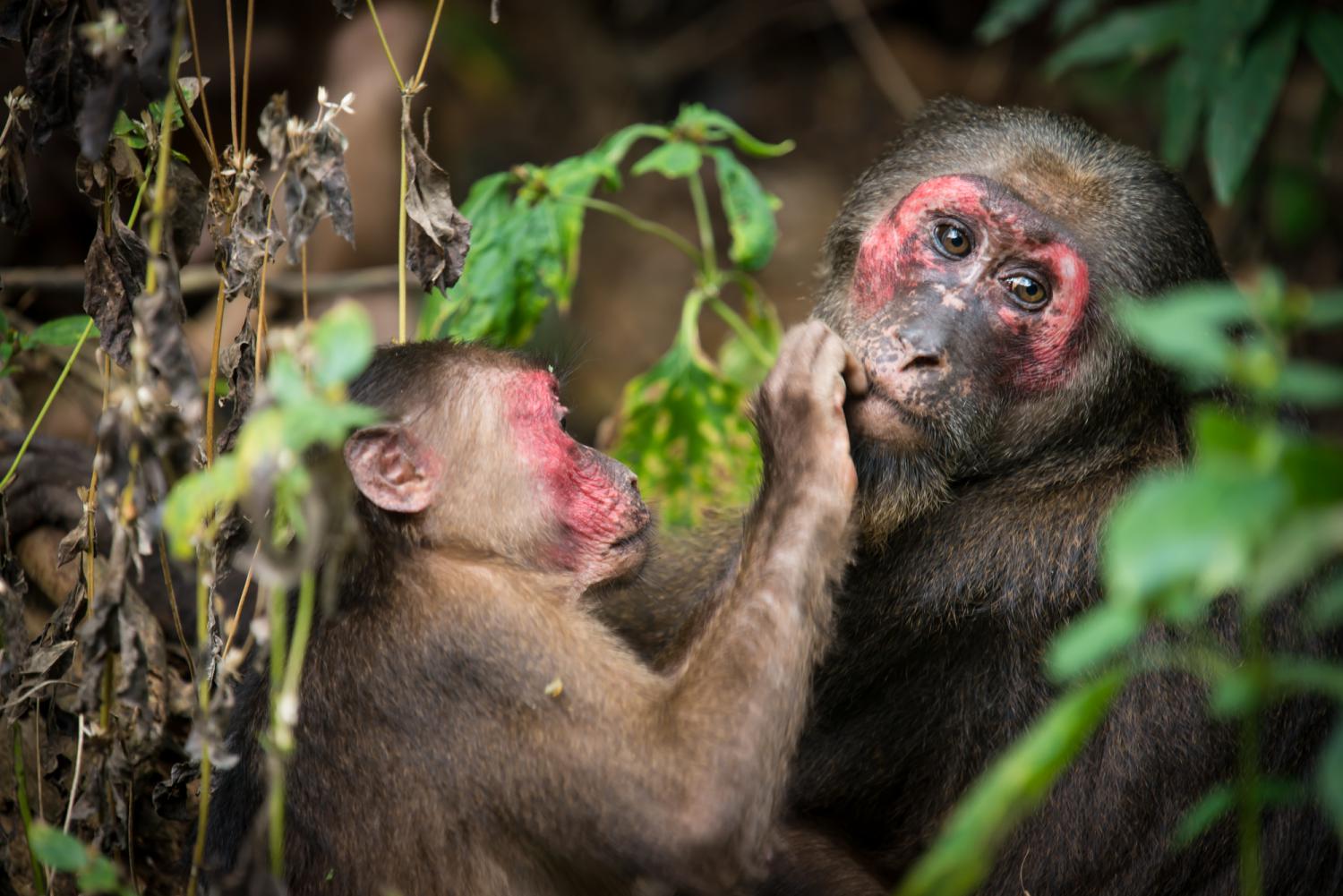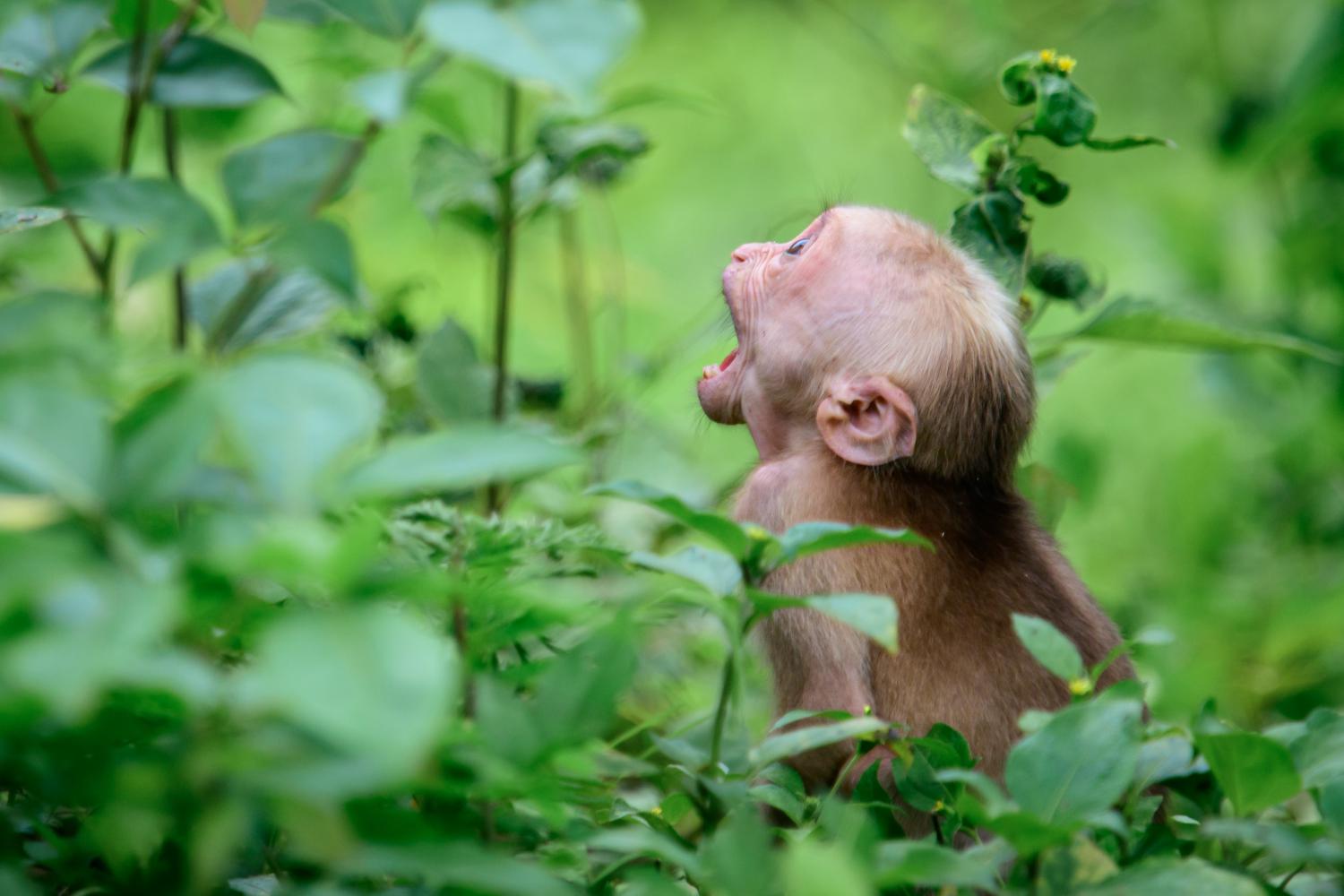Species of Thailand
Stump-tailed macaque
Macaca arctoides
(Isidore Geoffroy Saint-Hilaire, 1831)
In Thai: ลิงเสน
The stump-tailed macaque (Macaca arctoides), also called the bear macaque, is a species of macaque native to South Asia and Southeast Asia. In India, it occurs south of the Brahmaputra River, in the northeastern part of the country. Its range in India extends from Assam and Meghalaya to eastern Arunachal Pradesh, Nagaland, Manipur, Mizoram and Tripura.
It is primarily frugivorous but eats many types of vegetation, such as seeds, leaves and roots. It also hunts freshwater crabs, frogs, bird eggs and insects.
Characteristics
The stump-tailed macaque has long, thick, dark brown fur covering its body, but its face and its short tail, which measures between 32 and 69 mm, are hairless. Infants are born white and darken as they mature. As they age, their bright pink or red faces darken to brown or nearly black and lose most of their hair. Males are larger than females, measuring 51.7–65 cm long and weighing 9.7–10.2 kg, while females measure 48.5–58.5 cm and weigh 7.5–9.1 kg. Males' canine teeth, which are important for establishing dominance within social groups, are more elongated than those of the females. Like all macaques, this species has cheek pouches to store food for short periods of time.
Distribution and habitat
This Old World monkey travels quadrupedally, usually on the ground, as it is not very agile in trees. It is generally found in evergreen tropical and subtropical moist broadleaf forests, at different elevations depending on the amount of rainfall in the area. It depends on rainforests for food and shelter, and is not found in dry forests except where it ranges in the Himalayan region of India, only spending time in secondary forests if it is bordering old-growth forest tropical forests. With its thick fur, the stump-tailed macaque can live in cold climates at elevations up to 4000 m. It is distributed from northeastern India and southern China into the northwest tip of West Malaysia on the Malay Peninsula. It is also found in Burma, Thailand, Laos, Cambodia and Vietnam. It is possibly extinct in Bangladesh. No global population estimate is available. In Cambodia, a declining population of 230 is reported from Keo Seima Wildlife Sanctuary.
A study population was introduced to Tanaxpillo, an uninhabited island in Lake Catemaco, Veracruz, Mexico in 1974, where it ranges in seminatural conditions. Most information on the species comes from the introduced population on Tanaxpillo and other captive settings, as few long-term studies have been conducted on the stump-tailed macaque in the wild.
Behaviour and ecology
Stump-tailed macaque generally share the same social structure of any macaque species, with a linear, hereditary dominance hierarchy hereditary in females yet fluctuates among males based on their fighting ability and social maneuvering. Compared to rhesus and long-tail macaques, stump-tails defuse intense confrontations, are relatively tolerant of group members, and have a surprisingly rich repertoire of reconciliation tactics. This species lacks pair bonds and is promiscuous, a staple for macaques. Physical violence very rarely occurs, and although minor scraps often flair up and physical intimidation displays occur, they tend to quickly be resolved, resulting in this species being labelled as peaceful. Stump-tailed macaques are remarkably unfussy in their eating habits, though fruit generally is a staple part of their diet. Stump-tail macaques have a large, bulky, muscular build with thick, solid limbs, making them very mobile on land yet quite ungainly in trees, and this unusual physique for a macaque may be responsible for this species unique tendency to consume larger quantities of meat than other macaque species. Stump-tail macaques feed on very large quantities of insects, small animals and eggs.
Reproduction
A study population of female stump-tailed macaques was found to have increased levels of steroid sex hormones, specifically 17β-estradiol and progesterone levels. 17β-estradiol levels were significantly greater during summer and fall and progesterone levels were significantly greater during summer, fall and winter. This explains how stump-tailed macaques have two mating seasons per year: one in summer (July–August) and one in fall (November). This is supported by the distribution of birth frequency in stump-tailed macaques.
This article uses material from Wikipedia released under the Creative Commons Attribution-Share-Alike Licence 3.0. Eventual photos shown in this page may or may not be from Wikipedia, please see the license details for photos in photo by-lines.
Scientific classification
- Kingdom
- Animalia
- Phylum
- Chordata
- Class
- Mammalia
- Order
- Primates
- Family
- Cercopithecidae
- Genus
- Macaca
- Species
- Macaca arctoides
Common names
- German:
- Bärenmakak
- Stummelschwanzmakak
- English:
- Bear macaque
- Stump-tailed macaque
- Stumptail macaque
- Spanish: Macaca ursin
- French: Macaque brun
- Italian: Macaco orsino
- Dutch: Beermakaak
- Thai: ลิงเสน
Synonyms
- Macaca melli, Matschie (1912)
- Macaca harmandi, Trouessart (1897)
- Macaca speciosus, Murie (1875)
- Macaca rufescens, John Anderson (1872)
- Macaca brunneus, John Anderson (1871)
- Macaca ursinus, Gervais (1854)
- Macaca melanotus, Ogilby (1839)
Conservation status

Vulnerable (IUCN3.1)
Photos
Please help us review our species pages if wrong photos are used or any other details in the page is wrong. We can be reached via our contact us page.
Range Map

- Hua Hin District, Prachuap Khiri Khan
- Huai Kha Khaeng Wildlife Sanctuary
- Huai Yang Waterfall National Park
- Kaeng Krachan National Park
- Khao Banthat Wildlife Sanctuary
- Khao Luang National Park
- Khao Sok National Park
- Khlong Saeng Wildlife Sanctuary
- Kui Buri National Park
- Mae Nam Phachi Wildlife Sanctuary
- Mae Wong National Park
- Mueang Krabi District, Krabi
- Ngao Waterfall National Park
- Pang Sida National Park
- Pran Buri District, Prachuap Khiri Khan
- Royal Chumphon Forest Park
- Sadeth Naikrom - Krom Luang Wildlife Sanctuary
- Sai Yok National Park
- Sri Phang Nga National Park
- Tha Yang District, Phetchaburi
- Ton Nga-Chang Wildlife Sanctuary







